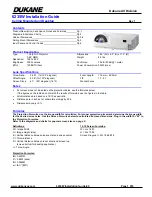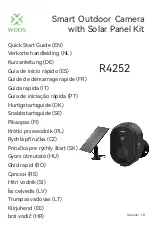
Cheetah Pregius Camera with GigE Vision
®
Interface – User Manual
August 27, 2019
Page
109
of
123
Rev 1.0
Slave AOI
A Slave AOI (SAOI) used to apply a look-up table (LUT) to a selected region of the image or to
calculate white balance coefficients from a selected region within the image. The selected
region can be within the SAOI or outside the SAOI (“Exclude” option). Alternatively, the SAOI
can be used to further refine the camera output so that only the pixels within the SAOI are
output or only pixels within the ROI, but outside the SAOI (“Exclude” option) are displayed
). When SAOI is enabled with AEC/AGC, the auto gain and auto exposure
corrections will use luminance values calculated from inside or outside the selected AOI and
then apply the determined exposure and gain settings to the full image..
Table 43:
Slave AOI modes
Test pattern
Description
Disable
Slave AOI disabled
Include
Slave AOI is included to the image, all the rest area is black
Exclude
Slave AOI is excluded from the image, all the rest area is included
AEC_AGC_Include
Slave AOI is included to AOI, used for Auto Gain Control (AGC) and/or Auto
Exposure Control (AEC). Luminance calculated inside the selected AOI
AEC_AGC_Exclude
Slave AOI is excluded from AOI, used for Auto Gain Control (AGC) and/or
Auto Exposure Control (AEC). Luminance calculated outside the selected AOI
AWB_Include
Slave AOI is included to AOI, used for Auto White Balance (AWB)
AWB_Exclude
Slave AOI is excluded from AOI, used for Auto White Balance (AWB)
LUT_Include
Slave AOI is included to AOI, used for Look Up Table (LUT)
LUT_Exclude
Slave AOI is excluded from AOI, used for Look Up Table (LUT)
5.12 Gamma Control
The camera’s built-in processing engine enables adjustments to the luminance (brightness) of
an image on the monitor. Using gamma correction, you can control, stretch, or compress the
image luminance with one of four different LUTs. All four LUTs are pre-programmed at the
factory with Gamma 0.45, but you can upload your own LUTs, if desired. (See section
).
5.13 Bad Pixel Correction
A CMOS imager is composed of a two-dimensional array of light sensitive pixels. In general,
the majority of the pixels have similar sensitivity. However, some pixels deviate from the
average pixel sensitivity and are called “defective pixels” or “bad pixels” In most cases, bad
pixels are responsive to light, and rarely is a pixel totally dark or totally bright. At the factory,
final testing identifies and corrects up bad pixels using bad pixel correction.















































